Kleiner Perkins has been top-notch in project capital and Silicon Valley’s history.
Over 47 years, the Sand Hill Road company has made more than 900 investments, including early bets on Amazon (ticker: AMZN), Google, Twitter (TWTR), Genentech, Snap (SNAP), Netscape, Sun Microsystems, Square (SQ), Electronic Arts (EA), and Slack Technologies (WORK).

But a decade ago, hiring Mary Meeker from Morgan Stanley took Kleiner Perkins in a new direction, with a developing awareness of past due-level investments. The method was never aligned with KP’s extra begin-up, seed-spherical lifestyle. Last year, Meeker left to install her store, one of many changes in a tumultuous period for the firm. The mythical John Doerr isn’t concerned with the firm’s modern-day fund. Once-outstanding partners Bing Gordon, Randy Komisar, and Beth Seidenberg are now “advisers.” Gen. Colin Powell (employed in 2005) and former Vice President Al Gore (signed as an associate in 2007) play a sizeable role.
Last month, KP announced its 18th fund, a $ 100 million bet on early-degree investing. The tight awareness on seed and Series A rounds is a Back to the Future moment for Kleiner—indeed, that’s the headline on a June blog post announcing the brand new fund.
Kleiner has retooled and streamlined, with five key partners using the company. The number one holdovers are coping with associate Ted Schlein, a 23-year KP vet and IT safety specialist, and Wen Hsieh, a “difficult tech” professional who joined in 2006. The critical new hires are Mamoon Hamid, who joined in 2017 from Social Capital; Ilya Fushman, who was hired in 2018 from Index Ventures; and Bucky Moore, a cloud computing expert, who lured away the remaining 12 months from Costanoa Ventures.
I met with Hamid, Fushman, and Hsieh at Kleiner HQ in Menlo Park, Calif., and later used a smartphone with Schlein to talk about the brand-new Kleiner and where the firm is putting new bets. “We recognize what we’re, and we recognize what we’re not,” Schlein says. Everyone jelled. We’re all inside the identical business. It’s just kind of rocking.”
The company targets four areas—enterprise tech, patron tech, financial era, and what Hsieh calls “hard tech.” Companies targeted “essential new constructing blocks required in distinct industries to take them to the following stage.”
Hsieh is Kleiner’s mad scientist, searching for some distance-fetched ideas with difficult odds but the capacity to drive rich returns and enormous international alternate. Hsieh is interested in space technology, which he says has historically supposed constructing release automobiles with a lot of “fanfare, smoke, and heat—a 20-tale tall thing full of liquid propellant.” He’s focused on SpinLaunch, a Long Beach, Calif., agency that has raised $ 40 million to fund an “electric kinetic” launching gadget for low-Earth orbit satellites—essentially a space catapult. Hsieh says the device should reduce the value of launching a 100-kilogram payload from more or less $2 million to $4 million to $ hundred 000 to $200,000. The catapult hurls stuff most of the way into space, using small booster rockets at the very last stage.
Hsieh also likes Desktop Metal, a Burlington, Mass., organization building that prints metallic components at room temperature. The old method requires melting metals, casting them, and “machining the hell out of it to put off 90% of the cloth you don’t need,” he says, a wasteful and energy-inefficient process. With Desktop Metal’s technique, Hsieh says, “You could print crankshafts to your table with better mechanical homes than a forged or forged crankshaft.” He sees “huge implications for production costs, time to availability, and logistics and supply-chain stock.”
Like Fushman, who was an early investor in Slack, Hamid sees substantial possibility in creating new companies focused on agency information employees—a group of approximately one billion people—all looking for better ways to accomplish work.
One of his bets is Figma, a San Francisco-based collaborative layout software enterprise that raised $80 million. Think of Figma as the design equivalent of Google Docs in word processing. Figma is collective, actual-time, and all internal a browser—there’s no stand-by-me utility. “It’s taken off like loopy inside the design community inside the final year or year and a half,” he says. Figma is going after a market ruled via Adobe (ADBE), but Hamid thinks the real opportunity is broader. Ten years ago, he says, tech companies hired one clothier for every 30 engineers. Today, the ratio is one for every seven engineers.
In virtual fitness, Kleiner has bets on Livongo, a Mountain View, Calif., agency targeted on chronic sickness control, starting with diabetes; Modern Health, a San Francisco corporation, which mixes elements of meditation and psychotherapy to focus on “emotional well-being,” handing over services through employers; and San Francisco-based Viz.Ai, which applies cloud-based totally system studying to read clinical images and unexpectedly locate blockages within the mind.

